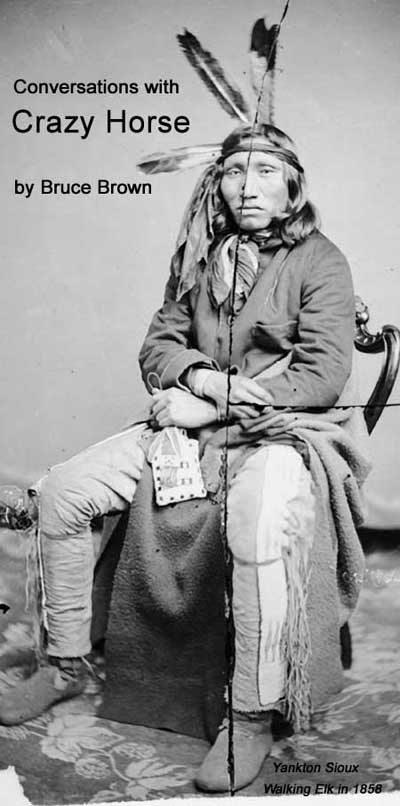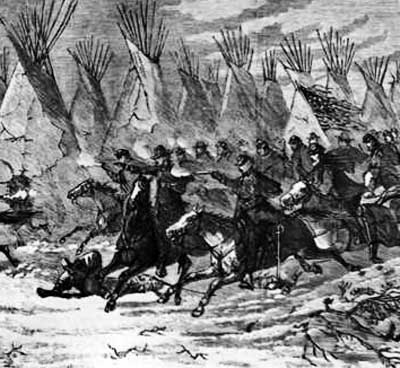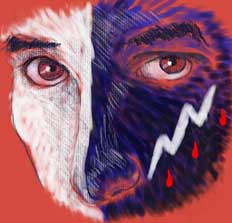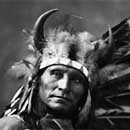|
She leveled her gaze at me and replied flatly, "I find your comment completely inappropriate." Suddenly, there was a scuffling of chairs as some of the clientele shifted around for a better view if there was going to be a scene.
Utterly nonplused, I opened my mouth and without warning Crazy Horse said...
In truth, there are no inappropriate words. Just crude scrawlings of the heart -- those that are heard, and those that are not.
Hoka hey! I wouldn't have believed it if I hadn't seen it with my own eyes. The waitress -- turned out her name was Kristin -- blinked twice and gave me a Major Reappraisal, looking me up and down and finally concluding with a shy smile, "yea," before hurrying off to deliver someone's hot buttered cinnamon roll.
Those ten seconds were the highlight of my life for about a week there. Meanwhile, at night, things started to turn around a little bit. I was becoming more subconsciously alert to the presence of my dreams. I could feel the minute variations in the flow of sleep that signaled a dream nearby, the way you can feel a salmon in the water near your hand, even though you're not actually touching.
My dreams were all tiny, darting things then, but I learned how to shepherd them through the dark grottos of the night, keeping them together and warding off dream catchers and other predators of the soul. In the process, without ever really trying -- or even knowing to try -- I began to develop some slight, miniscule dream power.
I think I was first aware of it when I accidentally touched one of my darting dreams for an instant in the sleep current. Even in that momentary encounter, I could feel the almost electrical life energy there, something more vibrant and alive than what we normally experience in "real" life. And I knew that the dream felt me touch it too.
The experience was so vivid that I almost jumped out of my sleep right then. It was like picking up an old shirt in the basement, and suddenly discovering it's throbbing with a nest of baby mice. The next morning, that dream sense of terror mixed with awe persisted, but curiously, I felt better than I'd felt in weeks, months maybe.
Then Crazy Horse returned. He said...
Put your dreams on. Get inside them. Wear them in the world.
I replied...
They're still kind of small for that, don't you think?
Crazy Horse said...
Even the smallest dreams contain truth.
I was dubious ...
Little itsy bitsy, teeny weeny truth?
Crazy Horse said...
Big truth. Sacred truth.
I asked...
So dreams are sacred?
Crazy Horse said...
Not all dreams are sacred. A person may only have one or two sacred dreams in their whole life. But all dreams have power because they are pathways to the Spirit World. Follow them, and they can lead all they way to Wakan Tanka, the Great Mystery at the center of all things.
I asked...
OK, but what about THIS world? Nothing happens in this world without hard work.
Crazy Horse replied...
Dreaming is what produces success in this world. If you can't dream, you work without real purpose. You may even become a soul slave, advancing someone else's purpose and power. And those who have been enslaved by soulless shadow beings -- your so-called corporations -- lose their souls completely.
I laughed. Crazy Horse didn't seem amused. He said...
America -- Land of Corporate Soul Slaves!
Then in a different voice, he continued...
Find the truth in your dreams. Get inside it and understand what it means. That's where you'll find your power and your life path.
CRAZY HORSE found his power and his life path in a dream that towers over the history of the Great Plains like an afternoon thunderhead.
In fact, you could hardly ask for a clearer example of how dreams can affect the real world than the vision that Crazy Horse had as a young man, although (as with everything else about Crazy Horse) there is a great deal of confusion about his first vision -- its time, its place, its meaning.
The standard biography of Crazy Horse, Mari Sandoz's Crazy Horse: Strange Man of the Oglala, places it during late August 1854 in the Sand Hills of Nebraska, while the best of the newer biographies, Kingsley M. Bray's Crazy Horse: A Lakota Life, places it circa 1860 on Rosebud Creek in what is now Montana. Sandoz portrays the vision as a gift of the Sky Powers in the guise of Thunder, while Bray portrays it as a gift of the Earth Powers in the guise of Water, which is to say not the power of Thunder, but power over Thunder.
If Sandoz is correct, Crazy Horse's first vision came a few days after he witnessed the Grattan Massacre, where U.S. Army troops commanded by a hotheaded Second Lieutenant named John Grattan murdered a friendly Brule Sioux chief named Conquering Bear in an argument over an old cow. Conquering Bear, who was the first Sioux to sign the Treaty of 1851, reportedly called out for peace just before he was cut down by the Americans' volley, whereupon the enraged Sioux killed Grattan and all 29 of his men.
If Bray is correct, it occurred after the subsequent Harney Massacre, where U.S. Army troops under the command of Gen. William Harney murdered 86 Sioux -- many of them women, children and old men -- in "retaliation" for the Grattan Massacre (that's right-- the Americans murder, and then they "retaliate"). In both cases, the American troops approached under flag of parley and then sucker-punched the unsuspecting Sioux.
Either way, Crazy Horse's first vision was a dream of war, born of American treachery and the smell of burnt flesh, and it was a dream of power, beyond the memory of any living Sioux. The renowned Sioux holy man Black Elk, whose father was a cousin of Crazy Horse's father, said "When I was a man, my father told me something about that vision. Of course he did not know all of it; but he said that Crazy Horse dreamed and went into the world where there is nothing but the spirits of all things. That is the real world that is behind this one, and everything we see here is something like a shadow from that world."
Most accounts (except the obligatory contradiction from Oglala holy man Horn Chips) agree that Crazy Horse dreamed he saw a mounted warrior rise up out of a lake and ride in the air. The warrior wore only a breechclout, a stone earring and one feather in his loose, unbraided hair. In some versions of the dream, the rider's face is unpainted. In others, he is described as having a red or white lightning bolt on his left check, where Crazy Horse later survived being shot point-blank in the face, and where he typically painted a lightning bolt when he prepared himself for battles like his great victory at the Rosebud.
The dream rider's horse is frequently described as rainbow-hued, but likewise unadorned and carrying no scalps or victory trophies to display his prowess. According to the bare account provided by interpreter Billy Garnett, who claimed to have heard it first hand, the dream rider spoke to Crazy Horse, telling him that he could not be killed by bullets if he dusted himself with "dirt thrown up by the pocket gophers" and wore "two or three straws of grass 2 or 3 inches long" in his hair.
Then the "rider from the lake" flew straight ahead into a raging thunder storm. Lightning flashed out of the dark dream clouds and hail fell in flailing sheets, but neither lightning nor hail struck the rider as he flew through the storm to the other side where Crazy Horse saw a prairie hawk circling high above in a distant patch of blue. The dream faded when Crazy Horse felt himself being shaken by his father, also called Crazy Horse, and his good friend, Hump, who had come searching for him that summer afternoon.
When Crazy Horse's father -- who was a medicine man, not a warrior -- heard his son's vision, he was awestruck. In fact, the elder Crazy Horse was so impressed that he soon relinquished the family name Crazy Horse to his son, taking for himself thereafter the name Worm. It was at this moment, after an exceptionally daring raid on the Arapaho in the Wind River country in 1858, that the Crazy Horse we know stepped fully formed onto the stage of world history, glittering like a newly pupated dragonfly in the Western sun.
That day he charged alone into the enemy, counting coup three times and escaping untouched though a hail of enemy fire. Then he single-handedly charged the Arapahos again, who this time sent out two warriors to meet him in the open ground between the two warring cavalry forces. Crazy Horse killed both the Arapaho champions in mounted hand-to-hand combat, but he was wounded in the leg when he dismounted to scalp the two men he'd just slain.
Afterwards, Worm supposedly told his son that he'd been wounded because he hadn't followed the dream riders' example. Crazy Horse reportedly never took another scalp. In 1865, when he was made a Shirt Wearer, or leader of a Sioux warrior society, the elders of the tribe presented him with a ceremonial staff that was adorned with 240 tufts of hair, each representing an exploit of his in battle, but he never used it.
Young Crazy Horse's first dream vision also revealed his Wasicunpi or guardian spirit, the high flying, far seeing, fast-killing prairie hawk. Thereafter, the hawk was both a source of inspiration and guidance, and a sort of heraldic emblem for the Lakotas' greatest war chief. Later pictographic battlefield paintings by his old friend and comrade-in-arms, Kicking Bear, show Crazy Horse with a hawk wotawe on his head, even though he didn't actually wear a stuffed hawk on his head when he rode into battle.
In spiritual terms, Crazy Horse's first dream gave him power over Thunder (which the Sioux believed controlled firearms), while subsequent dreams gave him the power Thunder itself. So as part of his spiritual practice, Crazy Horse studied the manifestations of Thunder in the world -- how the awesome peels rolled across the prairie, as well as the creatures that the Lakota believed were the emissaries of Thunder, including the hawk, the bat, and the dragonfly.
All three of these creatures are aerial hunters, and all three strike their prey in ways that mask their presence until the moment of the kill. Hawks dive out of the sun, bats forage in the dark, and dragonflies use what contemporary entomologists term "motion camouflage," a stealth technique that allows a predator to shadow its prey without detection. Male dragon flies do this by keeping themselves positioned against a fixed point in the background while closing for the kill. This means that although they are moving very fast, they appear stationary to their prey until, bam, they strike their unsuspecting victim.
There is no way of knowing what Crazy Horse took from his summers watching hawks and dragonflies and bats hunt the thunder-charged air above the Great Plains, but he grew to be a master of the trap, the decoy, the ambush, and the utterly unanticipated and utterly lethal first strike. Capt. William J. Fetterman had no idea of the mortal danger when he followed Crazy Horse's brilliant decoy maneuver over snowy Lodge Trail Ridge just before the Fetterman Massacre, and a decade later Gen. George Crook had no idea of the furious whirlwind that was about to strike as he and his men sat resting with their saddle girths loosened that sunny morning on the Rosebud.
In his thirties, additional dreams brought Crazy Horse the power of prophesy. His so-called Great Vision -- which Bray places on the Powder River circa 1875 and Vinson Brown places at Bear Butte circa 1871 -- foresaw the conquest of his people by the evil Americans in agonizingly prophetic detail. He saw the death of the buffalo and the degradation of the Sioux and the Cheyenne as the years of American enslavement wore on, but he also saw a nine-pointed star rising in the east, which he took to mean that the Great Sioux Nation would rise again with the addition of two new tribes to the Sioux Council Circle.
And dreams ultimately brought Crazy Horse the power of healing too. He is credited with creating a ceremony called Eagle Doctoring, which is still practiced by the Sioux on the Pine Ridge Reservation. Eagle Doctoring is used to treat tuberculosis, which struck Crazy Horse's wife, Black Shawl Woman, the winter after the Battle of the Little Bighorn. Black Shawl Woman ultimately outlived Crazy Horse, although only briefly.
As a prophet, a healer, and a warrior with the power of all the primal elements of the Sioux universe, Crazy Horse was the most complete holy warrior or mujahidin of his time. "When he rode into battle" in a sacral context, Kingsley M. Bray wrote, "Crazy Horse was not simply a naked warrior with a curious paint design: his being crackled with the awesome destructive powers of the total cosmos."
Crazy Horse is also a perfect example of how America makes mujahidin: how America's history of human rights atrocities -- from the Washita Massacre to the Haditha Massacre -- has long sown dragons' teeth under America's own feet.
YOUR SOLDIERS murder women and children. Why?
I have to say Crazy Horse's question took me by surprise. At the moment, I was under the sink looking for the Bon AmiTM kitchen cleanser, the one with the little baby chicken that says, "SINCE 1886 -- HASN'T SCRATHED YET."®
Now the man is accusing me of murder? I said...
Wait a minute! I'm just standing here holding the Bon AmiTM. I've never killed anybody in my life. You got the wrong guy. Besides, you killed hundreds, possibly even thousands of people. Get real! You act like you’re so virtuous. What's the difference between all those people you killed and all the people Custer killed?
Crazy Horse said...
If I answer your question, will you answer a question for me?
I didn't exactly see how I could get badly hurt on that deal, so I said...
Sure. If you can show me the difference between Americans killing Indians and Indians killing Americans, I'll do my best to answer any question you care to ask.
I saluted sharply and added with what I thought was pretty wicked sarcasm...
Mr. Info at your service!
Now there was tumult on the other side. The first to speak was Hump.
You can't show him.
Another unknown voice, higher pitched and far older...
You-can-not-show-him.
Crazy Horse replied, not to me, but to the old voice mostly I think...
I can give him dream knowing.
Now I heard Black Shawl Woman's voice. She said...
Or you could just tell him.
Again there was the sound of staffs pounding in agreement on soft dirt. Crazy Horse seemed to soften a little too. He said...
Black Shawl Woman is right. If I brought them to you in your dreams, even in base low-res concept depth, your nightmares would be awful beyond description. You probably really would go insane then.
Wait a second, I thought. Is this dead guy inside my head laughing at me? No doubt about it, I got a whiff of very old, very dry sarcasm. Then it occurred to me that maybe I could put this on my resume for a job as cosmic comic -- dead men find me amusing!
The thrill was short-lived, though, for I quickly sensed that someone on the other side was being asked to speak, although no words were spoken, either with audible speech or in my head to communicate this to me. It was as if some invisible whorl of hoops within hoops was thrown, and we all waited until it had made its pass around the hoop of voices.
Finally, Black Shawl Woman sighed and spoke again. She was calm and direct and matter-of-fact, and I immediately believed everything she said...
There are rules of display in the Land of the Dead. Here, we experience full-vortex versions of each other from our last relationship with that spirit in life. Sometimes this means that two spirits experience another spirit here very differently. The most extreme example is with murder.
If a person kills another person in fair combat, the killer sees the person he killed in whole and healthy form here in the Land of the Dead. But if a person kills another person foully, the killer sees the person he killed in the form he left the corpse.
There was a long respectful pause. Then Crazy Horse said...
Custer's spirit is haunted in the endless un-day by the corpses of the innocent people he murdered. I never killed an American who wasn't an invader of my country, and so they walk whole before me now.
Spotted Tail mused...
I wonder if your good Christian Parson Chivington and the rest of the Colorado volunteers regret those women at Sand Creek, forever without noses, ears and vulvas to them in the Land of the Dead.
Black Shawl Woman again...
Whole and strong for all other spirits in the Land of the Dead, but for him eternally defiled and hideous.
A brash young man's voice spoke next. Somehow I knew it was Crazy Horse's younger brother, Little Hawk...
And forever showing up at the same parties!
Another woman's voice...
Do you think Custer regrets old Black Kettle and his wife too, ridden over and trampled to death under a white flag of peace?
There was another long pause, longer even. It went on and on, and suddenly it occurred to me that maybe I was supposed to say something. Jesus, I thought, what can I add to that? Probably shouldn't try to crack a joke. Can't talk about mountain bike gear either. Blessedly, Crazy Horse came forward again, speaking directly to me...
So we have given you some knowing of the Land of the Dead and the difference between Americans killing Indians, and Indians killing Americans. True?
I nodded, although I actually wasn't sure what I knew. Crazy Horse continued...
Then answer me this. Why do American soldiers kill unarmed women and children and old men?
I maneuvered...
Give me more. I need some specifics here.
Crazy Horse fired back...
At the Grattan Massacre, American soldiers murdered Conquering Bear and others. Then the Army prepared a report which whitewashed the murders, and the American Army murdered nearly half of Little Thunder's village on the Blue Water -- many of them women and children and old men -- using the Grattan Massacre as the justification for the Blue Water Massacre!
The Americans have done this over and over and over again. It is the American Way -- Grattan at Fort Laramie in 1854, Harney at the Blue Water 1855, Chivington at Sand Creek 1864, Custer at Washita 1868, Forsythe at Wounded Knee in 1890.
At Wounded Knee, the U.S. Army killed 153 Sioux who were trying to surrender, including 62 women and small children. Eighteen of the American soldiers later received the Congressional Medal of Honor for murder.
I said...
Hey, that was a long time ago. We were all Texans then. America's other 49 states have moved on and learned better.
Crazy Horse said...
Well, then what about this? At Haditha in Iraq on November 20, 2005, American soldiers killed 24 unarmed civilians, including 11 women and children. One old man was hauled out of his wheel chair and shot in the head, execution style. Then the American military issued a report which whitewashed the soldiers' actions and blamed it all on the dead victims!
I said...
I think most Americans are appalled by this sort of behavior. It is the exception, not the rule.
Crazy Horse continued...
On May 9, 2006 on an island in Thar Thar Lake in Iraq, American soldiers murdered an old man who was just looking out the window of his home, then they stormed the house arrested two unarmed men, handcuffed them and executed them without any provocation or reason at all.
I replied...
There are always going to be a few bad apples in the barrel.
Crazy Horse said...
The commander of the American troops at Thar Thar ordered his troops to "kill all military age men" they encountered, regardless of whether they were friends or enemies.
The order for the Thar Thar murders came from the American officer in charge, just like the orders for the murders the Platte River ferry and Fort Laramie came from the American officers in charge, Lt. Hugh Fleming and Lt. John Grattan.
How is the Iraq War order to "kill all military age men" different than the Americans' 1865 campaign against the Sioux, when General Patrick E. Connor ordered his men "kill every male Indian over twelve years old"?
Americans have been doing this for centuries. Must be a lot of bad apples in the American barrel!
I said...
Hey, Americans are just human beings. They're no different than anybody else.
Crazy Horse said...
Maybe the difference is that the American Army promotes soldiers who murder innocent people. Lt. Hugh Fleming was promoted to commanding officer at Fort Laramie the summer after he murdered five Miniconjous at the Platte River ferry.
I protested...
Come on! The next American commander at Fort Laramie, Colonel William O. Collins, was a much better officer. He tried to be your friend and you helped kill his son, Casper.
Crazy Horse paried...
Friends send troops into your homeland to kill you? Still, William O. Collins was a better man than Hugh Fleming. So was Casper.
Feeling perhaps that I'd finally scored a point or two, I continued...
Bad things happen in war. You know this!
Crazy Horse sprang sideways...
War? What's war got to do with it? Conquering Bear was a friend of the Americans! So was the 14 year old girl in Mahmoudiya, Iraq, who was raped by several Amercian soldiers before they set her body on fire to cover their crime.
The American soldiers in Mahmoudiya found their victims because they passed through a traffic checkpoint manned by American soldiers. A traffic checkpoint! Was this war?
Another whiff of ancient sarcasm. I replied...
Bottom line -- I don't think we Americans realize what's really going on. I don't think Americans think very much about what's being done in their name. In fact, I think Americans avoid thinking about it as much as possible. Instead, they go to the mall!
Crazy Horse said...
You kill because you don't know you kill?
I said...
I guess you could say that.
Crazy Horse said...
Then what's the virtue of your so-called "democracy," where the soldiers kill innocent civilians for hundreds of years without "knowing it"?
I was feeling kind of down -- not too proud to be an American. I started to say...
I don't know...
But then I realized I was alone in my own head. Crazy Horse and the rest of the voices were gone. Without me realizing it, they had slipped away, vanishing the way Crazy Horse's warriors vanished into swirling blizzard at Wolf Mt.
Next Chapter...
Revised May 5, 2010
"Conversations With Crazy Horse" © Copyright 2006 - 2010 Bruce Brown
|












